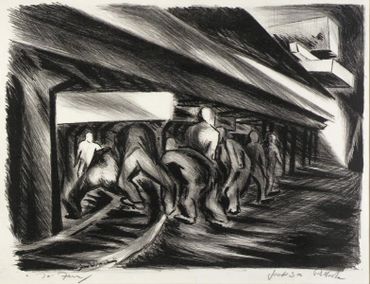Art Movement - Abstract Expressionism
Abstract Expressionism - (1940s and 1950s)
Abstract Expressionism was a major post–World War II art movement that emerged in the United States, particularly in New York City, during the 1940s and 1950s
Abstract Expressionism Art Movement
Abstract Expressionism was a major post–World War II art movement that emerged in the United States, particularly in New York City, during the 1940s and 1950s. It marked the first time American artists gained international recognition and leadership in the modern art world, shifting the center of the art world from Paris to New York. The movement emphasized spontaneous, expressive, and often large-scale works that focused more on emotion, energy, and process than on representational forms. Abstract Expressionists believed that art should come from the artist’s inner psyche and subconscious, serving as a direct channel for personal expression.
There were two primary tendencies within Abstract Expressionism: Action Painting and Color Field Painting. Action painters like Jackson Pollock emphasized dynamic gestures and physical engagement with the canvas, often using dripping, splattering, or pouring techniques to create energetic compositions. In contrast, artists such as Mark Rothko and Barnett Newman focused on large areas of color to evoke spiritual or emotional responses, using minimal form and subtle shifts in tone. Despite their stylistic differences, Abstract Expressionists shared a belief in the power of art to communicate profound human emotions and to break free from traditional artistic constraints. The movement paved the way for later developments in contemporary art and remains a defining moment in the history of American painting.
Jackson Pollock
Jackson Pollock (1912–1956)
He was an American painter and a leading figure in the Abstract Expressionist movement, best known for his revolutionary drip painting technique. Rather than using traditional brushstrokes, Pollock would lay his canvas on the ground and pour, drip, or fling paint onto it from above, using sticks, trowels, or even his hands. This method, known as action painting, emphasized the physical act of painting itself as an essential aspect of the finished work. The result was a web of dynamic lines, splashes, and rhythms that conveyed energy, emotion, and movement.
Pollock’s work marked a major departure from representational art and helped position the United States at the forefront of the modern art world in the mid-20th century. His most famous paintings, such as No. 5, 1948 and Autumn Rhythm (Number 30), are celebrated for their scale and complexity. Though he achieved fame during his lifetime, Pollock struggled with alcoholism and personal turmoil, which contributed to his untimely death in a car crash at the age of 44. Despite his short life, Pollock’s innovative techniques and raw, expressive style had a profound and lasting influence on contemporary art.

.jpg/:/rs=w:370,cg:true,m)


.jpg/:/rs=w:370,cg:true,m)
.jpg/:/rs=w:370,cg:true,m)
.jpg/:/rs=w:370,cg:true,m)
.jpg/:/rs=w:370,cg:true,m)
.jpg/:/rs=w:370,cg:true,m)
.jpg/:/rs=w:370,cg:true,m)
.jpg/:/rs=w:370,cg:true,m)




.jpg/:/rs=w:370,cg:true,m)
-c94d134.jpg/:/rs=w:370,cg:true,m)
.jpg/:/rs=w:370,cg:true,m)



This website uses cookies.
We use cookies to analyze website traffic and optimize your website experience. By accepting our use of cookies, your data will be aggregated with all other user data.


